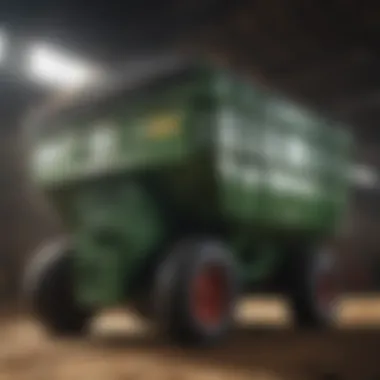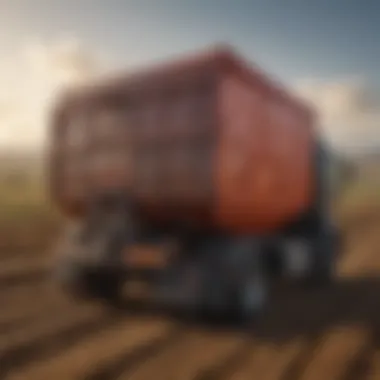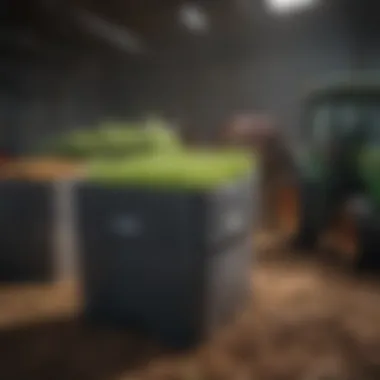The Role of Brute Bins in Modern Agriculture


Intro
The brute bin is an essential component in modern agriculture, designed to address the challenges of bulk storage and material management. From grains to fertilizers, these bins play a critical role in ensuring efficient agricultural operations. Understanding the fundamental aspects of brute bins, including their design and functionality, can significantly impact farming practices and enhance sustainability. This section will illuminate the key concepts and terminology associated with brute bins, setting the stage for an in-depth exploration of their specifications and applications.
Key Concepts and Terminology
Basic Definitions
A brute bin is a large storage container specifically engineered for the bulk storage of agricultural materials. These bins are often made from durable materials such as steel or reinforced plastic, designed to withstand varying weather conditions. The primary purpose of a brute bin is to provide a controlled environment for the storage of crops and inputs, minimizing spoilage and waste.
Historical Context
The evolution of brute bins reflects the broader advancements in agricultural technology. Historically, farmers relied on crude storage methods like open-air piles or simple wooden structures. As agricultural practices advanced, the need for better storage solutions became apparent. The introduction of engineered brute bins dates back to the mid-20th century when innovations in materials and design began to change the landscape of agricultural storage.
Recent Innovations and Trends
Technological Advancements
Innovation in brute bins has been driven by the need for efficiency and sustainability. Recent developments incorporate features such as:
- Augmented reality for monitoring levels
- Automated unloading systems
- Sensors for humidity and temperature control
These technologies not only optimize the storage process but also enhance the longevity of stored materials.
Sustainable Practices
Sustainability is becoming increasingly important in agriculture. New designs of brute bins focus on minimizing environmental impact. For example, solar panels may be integrated into the bin's structure to power internal systems. Additionally, materials used in construction are often recyclable, further supporting eco-friendly initiatives.
Practical Applications and Techniques
Step-by-Step Guides
When setting up a brute bin, certain steps should be followed to ensure optimal performance:
- Evaluate the storage requirement based on the volume of materials.
- Select an appropriate bin size and model.
- Prepare the site, ensuring proper drainage and level ground.
- Install the bin according to manufacturer's instructions.
- Implement monitoring systems to track conditions.
Case Studies
Consider the case of a mid-sized farm in the Midwest USA. The incorporation of a brute bin led to:
- A 30% reduction in grain spoilage during storage.
- Improved efficiency in loading and unloading processes.
- Positive effects on the overall supply chain, allowing for better market timing.
The role of brute bins in optimizing agricultural operations cannot be overstated. Their design, coupled with advanced technologies, opens up new avenues for efficiency and sustainability.
By understanding the basics and exploring recent innovations, farmers can make informed decisions about integrating brute bins into their operations. This knowledge lays the groundwork for a more comprehensive discussion of the implications and benefits of brute bins in the agricultural sector.
Prologue to Brute Bins
Brute bins play a critical role in the agricultural landscape. Their main function revolves around the efficient storage of bulk materials, which is essential for modern farming practices. Farmers and agriculturalists depend on these bins to manage and preserve their products, such as grains and fertilizers, in an effective way. This section will explore essential aspects of brute bins, establishing their importance in agricultural operations.
Definition and Overview
A brute bin can be defined as a robust container designed especially for holding large volumes of bulk products. These bins vary in size and construction, yet they generally prioritize durability and efficiency. Brute bins can store a broad spectrum of materials, including grains, seeds, and fertilizers, which are integral to farming. The design of these bins allows for easy loading and unloading, thus optimizing labor efficiency.
The materials used in making brute bins can range from steel to reinforced plastic, ensuring they can withstand both the physical burdens of storage and environmental conditions.


Benefits of Brute Bins:
- Efficient Space Utilization: Maximizes storage capabilities in limited areas.
- Protection from Elements: Safeguards material against moisture, pests, and other natural factors.
- Cost-Effective: Reduces waste and helps maintain product integrity over time.
Historical Background
The origin of brute bins can be traced back to the advancement of agricultural practices. Historically, bulk storage options were limited, often leading to significant product loss. Early storage methods included simple sacks or wooden barrels, which were far less effective than today's brute bins. As agriculture evolved and mechanization took place, the need for more efficient storage solutions became pressing.
In the 20th century, innovations in materials science and engineering led to the introduction of metal bins, which offered improved durability and safety. The introduction of standardized sizes made it easier for farmers to plan their storage and transportation needs, resulting in a more structured approach to agriculture.
"The evolution of brute bins signifies a transition towards efficiency in agricultural practices, reflecting broader advancements in farming technology."
As farmers adopted new techniques and technologies, they required better solutions to handle bulk materials. This need set the stage for the modern designs of brute bins we see today, which are specifically tailored to meet the demands of contemporary agricultural operations.
Design and Engineering of Brute Bins
The design and engineering of brute bins play a critical role in maximizing their efficiency and functionality in agriculture. Proper design ensures that these bins meet the specific needs of farmers and agricultural operations, allowing for optimal storage of bulk materials such as grains and fertilizers. Key considerations in the design process include material selection, structural integrity, and size and capacity. These elements are interrelated and contribute significantly to the overall performance of brute bins.
Material Selection
Material selection is fundamental in the construction of brute bins. Different materials offer varied properties that can impact the bins' durability and usability. Commonly used materials include steel, reinforced plastic, and concrete. Each material has its advantages:
- Steel: Known for its strength and longevity, steel is resistant to temperature fluctuations and environmental stress, making it ideal for outdoor storage. It can withstand mechanical loads, important for large quantities of bulk materials.
- Reinforced Plastic: This material is lightweight and resistant to corrosion, which suits certain types of fertilizers. Reinforced plastic has an edge in environments where moisture is a concern, as it does not rust.
- Concrete: While heavier, concrete bins offer excellent thermal insulation, which can be beneficial for grain storage by minimizing temperature changes.
Choosing the right material depends on various factors including cost, the type of bulk material stored, and environmental conditions.
Structural Integrity
The structural integrity of brute bins is essential for ensuring safe storage and management of materials. A bin with compromised structure may fail, leading to losses and safety hazards. Factors that contribute to structural integrity include design constraints, materials used, and the intended burden. For instance, a bin designed for storing grain must account for the weight and pressure created by the grains, preventing structural failure.
Engineers often conduct stress testing and simulations during the design phase. This helps in predicting how bins will behave under various conditions. Additionally, regular inspections and maintenance are crucial post-installation to uphold the structural integrity over time.
Proper engineering ensures that brute bins remain functional and safe, reducing the potential for hazardous failures.
Size and Capacity Considerations
Size and capacity considerations are pivotal in the effective utilization of brute bins. The bins must be adequately sized to hold the anticipated volume of material without overfilling, which can lead to waste or operational challenges. Capacity planning involves evaluating several factors:
- Storage Requirements: Determining the amount of material that will be stored and for how long contributes to selecting appropriate bin sizes.
- Space Availability: The physical space in which the bins will be installed can limit their size. A well-planned layout ensures that bins do not obstruct movement within the facility.
- Future Scalability: Considering future expansion needs may influence size selection. It’s essential to plan for growth to avoid a situation where existing bins become inadequate.
Ultimately, size and capacity are integral to ensuring functionality and efficiency, contributing to overall operational success in agricultural settings.
Functionality and Use Cases
The functionality and use cases of brute bins are pivotal to their role in modern agricultural practices. By understanding these aspects, farmers and agricultural enthusiasts can recognize how these bins impact efficiency and sustainability. The brute bin is not merely a storage unit; it is a multifaceted tool that allows efficient management of bulk materials.
Storage of Bulk Materials
Brute bins are primarily utilized for the storage of bulk materials such as grains, fertilizers, and even seeds. This capacity to hold large volumes in a contained space helps in streamlining agricultural processes. When grains are stored in brute bins, they are less susceptible to damage from pests and environmental conditions. The controlled environment provided by these bins can maintain optimal conditions for preserving the quality of products.
Some specific benefits of using brute bins include:
- Space Efficiency: Utilizing vertical space, brute bins can store significant amounts of material in smaller footprints, thus maximizing land use.
- Segregation: Different materials can be stored separately, reducing contamination risks, which is crucial for maintaining quality in agricultural products.
- Accessibility: Brute bins simplify access to stored materials, making it easier for farmers to manage their inventory.
Overall, the storage capabilities of brute bins significantly enhance the management of agricultural resources, providing an organized solution to bulk storage challenges.


Role in Logistics
Logistics in agriculture can often be complex, involving the movement of materials from one point to another efficiently. Brute bins play a crucial role in logistics, facilitating smoother operations in the supply chain. They serve as points of consolidation where bulk materials can be gathered before transportation or distribution.
The contribution of brute bins to logistics includes:
- Streamlined Transport: By centralizing storage, they reduce the number of trips needed for transporting bulk materials.
- Ease of Loading and Unloading: Brute bins can be designed for compatible use with various handling equipment, making the loading and unloading processes more efficient.
- Optimal Inventory Management: With brute bins, farmers can track their storage levels more easily, ensuring that they can plan for planting and harvesting seasons effectively.
"Brute bins simplify the logistics involved in agricultural operations by acting as efficient storage hubs."
Impact on Agricultural Practices
The introduction of brute bins has significantly impacted agricultural practices by providing an efficient solution for bulk material management. In contemporary agriculture, there is a growing need for systems that not only streamline operations but also support sustainability efforts. The brute bin achieves these objectives through its thoughtful design and functionality, resulting in substantial operational benefits.
Enhancing Operational Efficiency
Brute bins enhance operational efficiency in several critical ways. First, they allow for the easy storage of large quantities of materials such as grains and fertilizers. This capability reduces the need for frequent transportation, saving both time and resources. Farmers can store materials close to the point of use, leading to quicker access and minimizing delays in operations.
Second, brute bins facilitate better inventory management. Farmers can implement systems that monitor the levels of stored materials. This helps in optimizing the supply chain and ensuring that materials are available when needed without overstocking or spoilage. An effective inventory system can also reduce waste, which is crucial given the higher costs associated with agricultural supplies.
Another factor is the ability of brute bins to support mechanization. Many modern brute bins are designed to work with machinery such as augers or conveyors, enabling a seamless flow of materials during planting, harvesting, or processing. This integration reduces the need for manual labor, increasing overall productivity on the farm.
"Ultimately, effective storage solutions like brute bins are pivotal in the drive towards increased mechanization and smarter farming operations."
Facilitating Sustainable Practices
Sustainability is a major concern in modern agriculture, and brute bins play a role in addressing these challenges. Firstly, by optimizing storage conditions, they help maintain the quality of stored materials. For example, maintaining proper humidity and temperature can prevent spoilage, thus maximizing the use of resources and reducing waste. When farmers can store their materials effectively, they minimize the environmental impact associated with overproduction due to spoilage, thereby promoting sustainable methods.
In addition, brute bins can contribute to minimizing the carbon footprint of agricultural operations. By reducing the number of trips needed for transportation and ensuring that material losses are kept to a minimum, they enable farmers to operate more sustainably. Moreover, some brute bin designs utilize renewable materials or energy-efficient manufacturing processes, aligning with eco-friendly practices.
Lastly, brute bins support the use of precision agriculture. Advanced brute bin technology can integrate with data management systems that provide insights into the best usage practices. By employing this data-focused approach, farmers can make informed decisions that lead to more sustainable resource use and minimized environmental impact.
Challenges in Brute Bin Implementation
The implementation of brute bins in agricultural settings comes with its unique challenges that must be addressed for successful integration into farming operations. These challenges can impact the effectiveness of brute bins and their overall contribution to agricultural productivity. Understanding these issues is essential for farmers and agricultural managers looking to optimize their usage of brute bins.
Technological Limitations
Technological limitations are significant barriers in the adoption and effective use of brute bins. One major issue is the lack of standardized technology for bulk material handling, which can affect compatibility between different bin models and agricultural machinery. Moreover, many brute bins are not equipped with modern monitoring systems. These systems can significantly improve operational efficiency by allowing farmers to gauge the conditions of stored products. Without these technologies, it becomes difficult to ensure the integrity of materials over time.
Another concern is the variation in automation within farming operations. Farms that are heavily automated can benefit from smart brute bins integrated with software for real-time data analysis. Conversely, farms relying on outdated technology may find it challenging to adopt new systems, thus hindering the benefits of brute bins. This technological divide can result in unequal advantages in efficiency and productivity among farms.
Cost Considerations
Cost considerations play a crucial role in the decision-making process surrounding brute bin implementation. The initial investment for brute bins can be substantial, particularly for state-of-the-art models that incorporate advanced features like climate control systems or automated handling mechanisms. Farmers must evaluate whether the potential savings in efficiency and material preservation offset these costs.
Additionally, ongoing maintenance and operational costs must be factored in. Regular checks and repairs can add up over time, especially if the bins are not constructed from durable materials. Farmers need to analyze their operational budgets carefully.
Effective budgeting is vital to ensure that the costs related to brute bin use do not outweigh the benefits.
Case Studies: Successful Applications
The examination of case studies related to brute bins serves as a pivotal aspect in understanding their impact on modern agriculture. By showcasing specific instances of brute bin applications, we can identify the tangible benefits and insights garnered from real-world usage. These case studies not only highlight the efficiency of brute bins in various agricultural practices but also underscore their adaptability in responding to specific operational needs.


Grain Storage Solutions
One of the most significant applications of brute bins is in grain storage. Farmers often face challenges related to the preservation and management of harvested grains. Brute bins provide a solution by allowing for bulk storage without compromising grain quality.
- Capacity Management: These bins can hold a substantial amount of grain, which reduces the frequency of transport to market and decreases handling costs.
- Quality Preservation: Properly designed brute bins include features that help maintain optimal temperature and humidity levels, ensuring the grains stored do not spoil or suffer from mold.
- Pest Control: By utilizing airtight designs, brute bins minimize the likelihood of pest infestations, protecting the stored grains from damage.
Examples from farms that implemented brute bins for grain storage often report improved efficiency in handling their harvest. The time saved is significant, as farmers can focus on other important operational aspects instead of constant grain monitoring and transferring.
Fertilizer Management
Fertilizer management is another critical area where brute bins have proven beneficial. In large-scale agricultural operations, the effective handling of fertilizers is important for both crop yield and environmental safety.
- Bulk Storage: Brute bins allow for the storage of various types of fertilizers in bulk, which simplifies the logistics of managing these substances. This is crucial for maintaining a consistent supply during planting seasons.
- Safety and Compliance: The robust design of brute bins helps in adhering to safety regulations mandated for storing hazardous materials like fertilizers. The use of spill-containment features is essential to prevent leakage and contamination.
- Ease of Access: Many brute bins come equipped with built-in dispensing systems, allowing farmers to easily access and apply fertilizers as needed, enhancing productivity.
The integration of brute bins in fertilizer management thus not only streamlines operations but also promotes responsible agricultural practices. Farmers who have incorporated these systems have noted reduced waste and better fertilizer application rates, leading to healthier crops and a more sustainable farming approach.
Future Trends and Innovations
The future of brute bins in agriculture is very vital and encompasses multiple trends and innovations that promise to reshape storage and management of bulk materials. As the agricultural sector moves towards modern solutions, the integration of advanced technology and sustainable practices will be essential. This evolution not only enhances efficiency but also aims to reduce environmental impact. Understanding these trends provides a clearer perspective on how brute bins fit into the future landscape of agriculture.
Integration with Smart Farming Technologies
Smart farming technologies are becoming increasingly significant, and brute bins are not excluded from this transformation. These bins can connect seamlessly with various IoT devices to track inventory levels, monitor environmental conditions, and control the dispensing of materials.
Having smart sensors installed within brute bins can significantly enhance their functionality. Some benefits include:
- Real-time data collection: Farmers can get immediate access to vital information, such as the moisture content in grain, which helps prevent spoilage.
- Automated inventory management: With connected systems, agro-producers can receive alerts on storage capacity, enabling them to schedule deliveries and reorder supplies effectively.
- Remote monitoring: Smart bins allow for management and oversight without needing physical presence on-site, saving time and reducing labor costs.
With the pathways for further technological integration widening, it is crucial for farmers to stay abreast of these innovations. They enable a smoother transition into automated and data-driven agriculture practices.
Sustainability and Environmental Considerations in Design
As agricultural practices move towards sustainability, the design of brute bins has to align with these ideals. Modern brute bins are engineered to minimize waste and ensure longevity, addressing both environmental and economic concerns.
Critical aspects include:
- Use of recyclable materials: Many new designs incorporate materials that can be recycled after their lifecycle, reducing landfill contributions.
- Energy-efficient manufacturing processes: Processes that consume less energy during production help lower the carbon footprint.
- Temperature control features: Some bins now have thermal insulation capabilities to maintain the quality of the stored materials, further reducing spoilage and waste.
The emphasis on sustainable designs underlines an important consideration for the future of agriculture. The greater the focus on reducing environmental impacts, the more viable and accepted these innovations will become within agricultural practices.
"Integrating technology and sustainability into brute bin design is not just about efficiency. It is a strategy for long-term resilience in agriculture."
Future adaptations and enhancements in brute bin technology should align with broader agricultural goals of sustainability. By cultivating integration with smart technologies and emphasizing environmentally conscious designs, the agricultural sector can ensure its growth remains sustainable for future generations.
Closure: The Brute Bin’s Role in Modern Agriculture
The brute bin represents a critical component in the contemporary agricultural framework, influencing how bulk materials are managed and stored. Understanding this role allows us to appreciate its broad implications. Brute bins are structured to address the various needs of agricultural tasks, from optimizing grain storage to managing fertilizers efficiently. Their design and functionality promote not just convenience, but also sustainability, leading to a more robust agricultural practice.
Summary of Insights
The insights gathered from the comprehensive analysis of brute bins reveal their multifaceted benefits. One significant aspect is their capacity to enhance operational efficiency within agricultural settings. By simplifying the processes of storage and logistics, farmers can focus on their core activities without being bogged down by inefficiencies. Brute bins also play a pivotal role in ensuring the quality of stored materials. Proper storage conditions minimize spoilage and loss, directly impacting crop yields and overall sustainability.
Moreover, the adaptability of brute bins across various agricultural applications—ranging from grain handling to fertilizer distribution—demonstrates their versatility. In a world that constantly seeks sustainable solutions, brute bins serve as a practical answer by reducing waste and improving resource management in the farming sector. Thus, the overarching theme derived from this exploration underscores the bin's importance in enhancing agricultural practices while adhering to environmental concerns.
Final Thoughts on Future Applications
Looking ahead, the future applications of brute bins are promising. As agriculture adopts more smart farming technologies, the integration of brute bins with these innovations will likely result in enhanced monitoring and management capabilities. For instance, equipping brute bins with IoT technology can provide farmers real-time data on storage conditions, enabling timely interventions when necessary. This technological evolution can lead to significant improvements in operational efficiency and sustainability.
In addition, the growing focus on eco-friendly farming practices underscores the need for designs that prioritize sustainability. Trends indicate a movement toward materials that are not only robust but also recyclable or biodegradable. Fortunately, advancements in materials science continues to open new avenues for improving the sustainability of brute bins.
Thus, the brute bin is not merely a retention system for bulk materials; it is evolving into a critical element of the agricultural supply chain. The insights extracted from this discussion suggest that as technology and environmental demands change, so will the role of brute bins. Keeping pace with these changes will ensure that they remain relevant and beneficial in modern agriculture.















